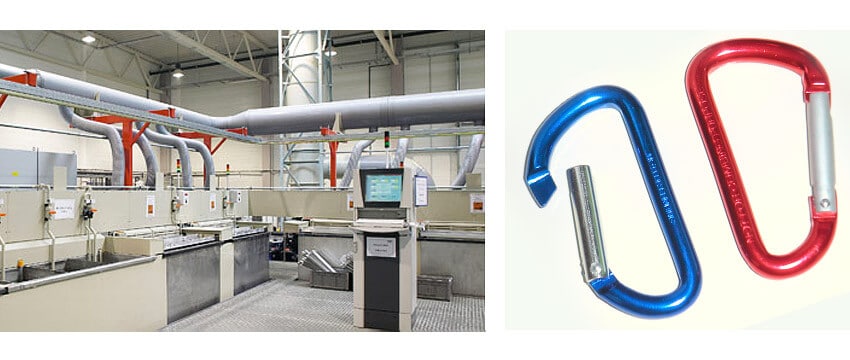- 0086-539-8039803
- rex@rexfactory.com
Commercial Anodizing Equipment
Anodizing is a process of treating the surface of an aluminum to convert it to aluminum oxide. Anodizing machines make this process more efficient, while providing the most reliable finish.
Anodizing aluminum takes so many processes to arrive at the state of aluminum oxide. The reason for anodizing aluminum is to make the oxide layer to thicken for wear and corrosion resistance.
To make an aluminum part anodic, it must pass through an electrolytic cell to make the chemical processes complete. Sometimes, people dye the oxide layer which forms on the aluminum to improve its appearance.

Apart from corrosion resistance, there are many reasons for the anodizing machine. When there is an electrolytic anodic coating on aluminum, it improves durability as a result of wear resistance.
Also, the aluminum thick state makes it harder as well. Anodizing machine improves its adhesive bonding, paint adhesion and enhances the aluminum capacitance in relations to electronic applications.
The process of aluminum anodizing is quite simple for those who work in the industry. It involves immersing the aluminum in the electrolyte which is, of course, an acid.
Then you apply direct current to it i.e. electrical current which in turn splits the water content of the acid into negatively charged oxygen and positively charged hydrogen.
The positively charged surface of the aluminum will attract the negative oxygen and the reaction results of these two chemical process will be the formation of aluminum hydroxide and other compounds that relate to it.
Anodizing Equipment List
To ensure a good result after anodizing machine, the right anodizing equipment must be in place for the whole process to
work.
1. Anodizing Tank
The first thing is the way you construct the anodizing tank. If you want to get a good anodizing tank, it must come in Polypropylene material because this tank material is more resistant to corrosion. The size of your tank may range from ½-inch thickness to 1-inch thickness and it will depend on the size of your tank. Sometimes, some external reinforcements
become necessary so that the tank will be stronger.
2. Water chillers
The tank’s temperature must not exceed the limit therefore, there should be sufficient cooling in the tank to make sure that the variation in temperature that may occur during the anodizing process will not be much. To achieve the cooling you require water chillers in the system so that chilled water will circulate in the tank from a water reservoir.
3. Rectifiers
For standard anodizing, the DC rectifiers will be up to 18 -24 V. The current output should be 12-24 asf. While hard coat applications will require about 75 V at the current output of 24 to 40 asf.
There are many control options for plating rectifiers which include voltage control, current control and adjustable ramping.
4. Cathodes
Aluminum cathodes with 6063-T6 alloy are necessary for newer systems and tanks. If you want to achieve a consistent result, use anode to cathode ratio of at least 3:1. As for older tanks or anodizing systems, lead cathodes is common in
them but aluminum is better if you want the parts to last for a longer time. Also, with aluminum cathodes, there will not be contamination in the bath from any metal and heat buildup will be lesser.
5. Sparger pipes
This anodizing equipment part is necessary to facilitate agitation. These pipes that have 3/32-inch holes disperse air near the anodizing tank bottom.
6. Pumps
If you don’t want to use the sparger pipes, pumps sizes of about 4 to 6 tank turnover/should be used to pump your anodizing solution. You can also make use of eductors to facilitate the solution flow. PVC hoods also come in handy to provide exhaust ventilation.
7. Racks
Most popular racks for anodizing equipment are titanium and aluminum. Aluminum racks come in 6061 or 606-T6 material while titanium racks come with pure titanium and are more costly.
8. Hoist
There is also a side-arm hoist to handle loads ranging from 250 to 750 1b. Also, if overhead hoists are required, it can carry a load of 2000 or 4000 1b.
Aluminium Anodizing Plant Costs
The cost of anodizing machines and associated equipment varies depending on the size of the system and your specifications.
There are low-price and higher-priced anodizing machines depending on what you have a budget for it. However, before ordering any aluminum anodizing machine, you must equip the sender with four important information about the requirement.
1. Alloy
It is true that you can apply aluminum anodizing on any alloy but don’t forget that no two alloys are the same. Therefore,
make sure that you specify the particular alloy for the aluminum anodizing on your purchase order or drawing.
2. Surface build-up
Be specific on the type of build=up you require. Let the sender understand that you need hard anodize buildup so that you will not get plating buildup.
3. Racking
Don’t forget the importance of properly racking the components so that both mechanical and electrical contact will be firm during the anodizing process. Therefore, make sure that you tell the fabricator the type of rack placing you require.
4. Masking
This process is necessary so that the coatings will not touch bored holes or threaded holes, mating surfaces, ground points or other areas that are not relevant. Make sure that you specify the areas where you want the providers to mask on your
purchase order or machine blueprint. This specification is very important to reduce high costs of masking due to wrong specifications.
